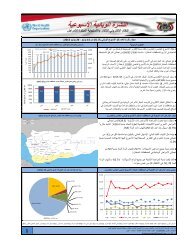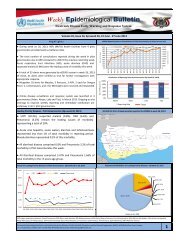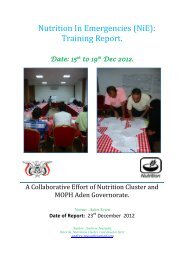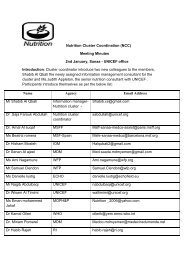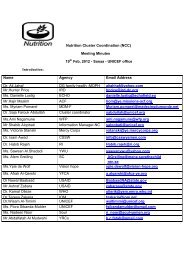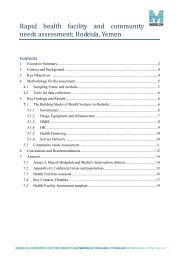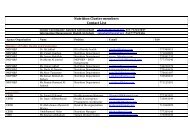Download - Yemen Humanitarian Response | YEMEN
Download - Yemen Humanitarian Response | YEMEN
Download - Yemen Humanitarian Response | YEMEN
Create successful ePaper yourself
Turn your PDF publications into a flip-book with our unique Google optimized e-Paper software.
Although a direct comparison is not possible, the Lahj health office health indicator datashowed a crude death rate (CMR) of 0.33/1000 indicating that these levels are comparable.Morbidity: High morbidity rates (from common child illnesses) were reported in the twoecological zones. The incidences of reported diarrhea in Lowland and Mountainous populations(27.9% and 28.8% respectively) within two weeks prior to the assessment were high as was theincidences of ARI and fever in the two ecological zones. The Lowland populations in particularhad a very high prevalence of ARI and Fever. These levels were consistent with the nationallevel figures. Nearly all (95-98%) of the community populations surveyed sought treatment forillness outside of the home. The majority of people sought treatment in a hospital/clinic/healthcenter; followed by private physicians.Infant Feeding: Among children aged 6 to 24 months, only 68-70% were still being breastfed.Among children 6 to 23 months of age and still breastfeeding, more than half (56-57%) ofchildren met the recommended minimum number of meals; while only 18-22% of nonbreastfedchildren received the respective minimum number of meals for their age in theprevious day.Food security: Borrowing money to purchase food or purchase food in credit or mortgage iswidely practiced. 29% in Mountain and 43% in lowland reduced meals size in the past 30 days;further almost one quarter of households in Lowland areas and 14% in Mountain reportedhaving to go to bed hungry in the 4 weeks prior to the survey. 17-25% of households reportedlyreduced the expenditure on education to save money to purchase food, over the 4 weeks priorto the survey. The result is indicative of household food insecurity, particularly in the Lowlandecological zone.Water and Sanitation: In Mountain community, approximately two thirds of the populationuses an improved source of drinking water. In Lowland, more than 83% population usesimproved water, with a nearly one-third using piped water connected to home. Overall, fewhouseholds treat water for drinking purposes. In Mountain community less than half of thepopulation (41.7%) used improved toilet facility, whilst in Lowland, the proportion ofhouseholds using improve facility increases approximately to 51%. Hand washing practicesamong the communities surveyed were highest before and after eating and after toilet use.Hand washing after disposing of children’s feces and before feeding children is low. Use of soapfor hand washing in general was good with 92-97% of population surveyed washed their handswith soap. About 16% people in the Lowland and 5% of the Mountainous community had beendefecating in the open field. Among the Lowland communities, more than two thirds (75.5%) ofthe people wash their hands after eating, while 70.1% washed before eating and 61.3% after9




